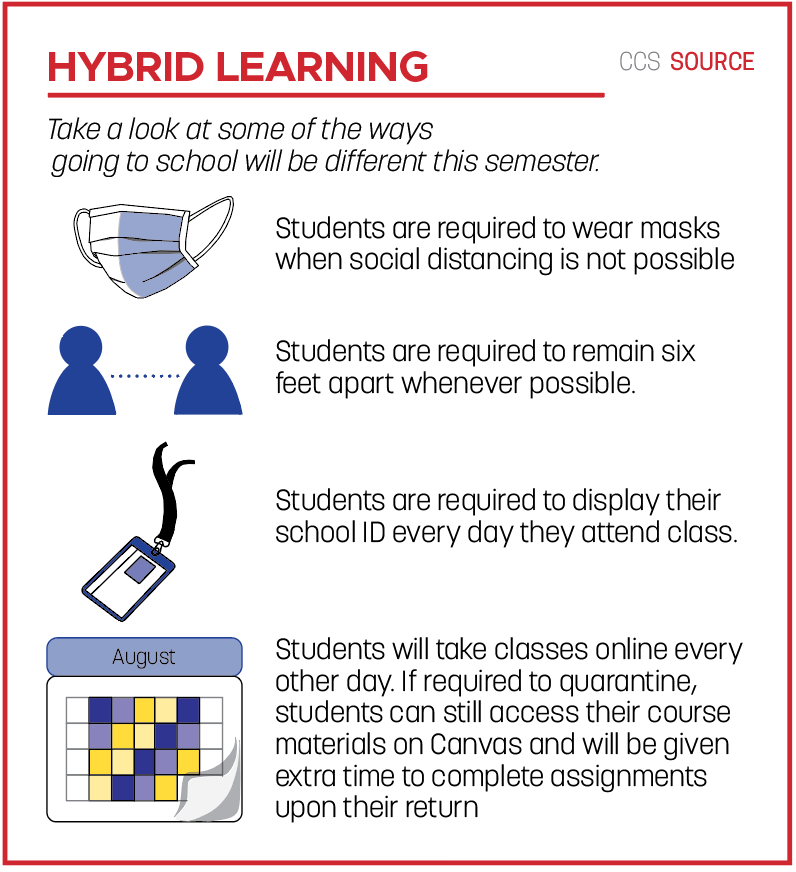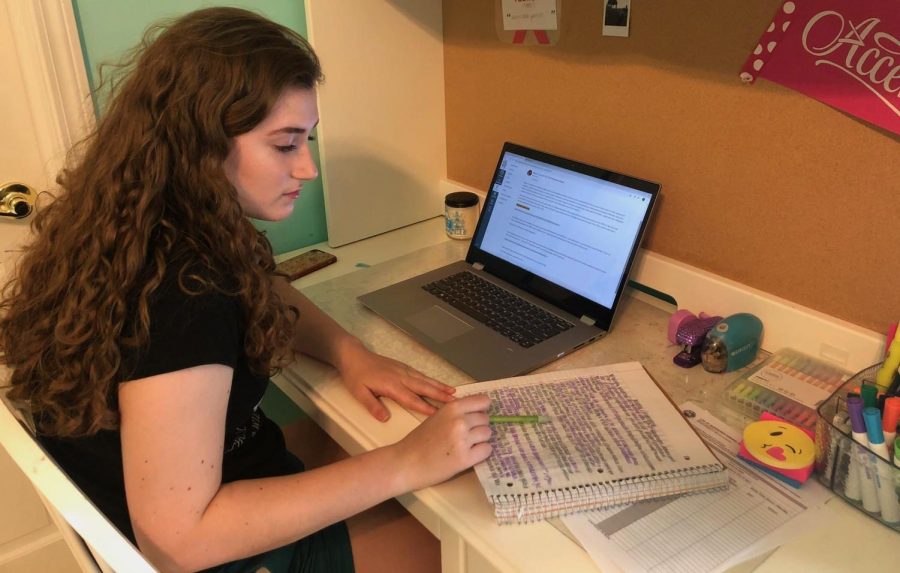In the 2019-2020 school year, teachers taught the final quarter of school entirely online after Carmel Clay Schools (CCS) closed on March 16 and Gov. Holcomb later ordered all K-12 schools in Indiana to remain closed for the rest of the school year. It’s likely that most, if not all teachers were not expecting to deal with a global pandemic and a full shift to virtual learning. Over the summer, however, hundreds of CCS teachers attended professional development workshops for virtual learning, including sessions on enhancing Canvas use and building a classroom culture online. Though CCS is set to reopen its doors today and resume in-person classes, virtual learning options are available to students as well.

According to Principal Tom Harmas, this year’s virtual learning will place a heavier emphasis on social-emotional learning (SEL). SEL includes the development of interpersonal skills, learning how to manage emotions and goal-setting, and it helped inspire Carmel’s Culture of Care.
“We’re very fortunate because most of our students are self-driven and want to do well in school, but for those who aren’t, it was difficult for us to have that communication and really help those kids that weren’t having a difficult time,” Harmas said. “That’s part of that SEL piece, creating a classroom culture and really trying to reach out to kids, making sure they know they have a partner in education—somebody who really cares about them—and that we want them to do well and we’re going to help them in any way that we possibly can.”
While seeing someone’s face through a screen and hearing someone’s voice through speakers isn’t the same as seeing and hearing them in person, conference calls through platforms like Zoom are often the closest students and teachers can get to a classroom setting in the confines of their homes. Senior Sarah Konrad said she hopes teachers will hold more conference calls for virtual learners this year, as some of her previous teachers did not hold any last school year.
“I love the classroom environment,” Konrad said. “I love getting to see everyone’s faces. I wish more teachers had held Zooms for us so that we could see each other and also see the teacher rather than just having this icon on a screen sending us a Canvas announcement. I wanted the human element.”
Harmas also encouraged teachers to hold more conference calls and live classes with students, describing the digital disconnect of virtual learning as something that could disrupt the bond between teacher and student.
“I think that education is about relationships, and it is more difficult to create a relationship virtually,” Harmas said. “I’m from the relationship generation, with the belief that when you can see a person’s face, when you can really hear their tone, you can better understand them. If you’re not doing Zoom classes and so forth, it’s difficult to get a read.”

Last school year, social studies teacher Sandy Gardner held several Zoom calls with her classes and also reached out to individual students who were struggling. She said many of her best conversations with students were one-on-one or in small groups, where students could get feedback catered more specifically to them. After having these individual conferences, she found that many students who initially felt overwhelmed were able to get back on track. For those who will continue virtual learning, Gardner said reaching out to teachers is key to being a successful student when not in an actual classroom.
“Communicate with teachers when you don’t understand what’s going on,” Gardner said. “You can’t just let it go. You can’t just be like, ‘Oh, I can’t figure it out’ and move on. And that’s a good lesson—you have to do that in life. You have to do that when you get a job, and you have to empower yourself to ask questions and get clarification so you can do your best work.”
Many questions about this school year still remain a mystery, especially as experts like Dr. Lisa Maragakis of Johns Hopkins Medicine have cautioned that a second wave of COVID-19 could possibly occur in the fall. However, Harmas said students and staff dealt well with the beginning of the pandemic in the spring, and if a complete return to virtual learning were necessary this year, he said teachers would remain flexible and communicative as much as possible.
“I really want to emphasize how proud I was of how our teachers and our students accepted the challenge and reacted in a positive manner to starting virtual learning right away,” Harmas said. “I want to make sure that everyone knows that… we’re doing professional development, and we’re getting better at what we do. It’s all about being able to meet the students’ needs.”
































![British royalty are American celebrities [opinion]](https://hilite.org/wp-content/uploads/2024/03/Screenshot-2024-03-24-1.44.57-PM.png)




















![Review: “The Iron Claw” cannot get enough praise [MUSE]](https://hilite.org/wp-content/uploads/2024/04/unnamed.png)
![Review: “The Bear” sets an unbelievably high bar for future comedy shows [MUSE]](https://hilite.org/wp-content/uploads/2024/03/unnamed.png)
![Review: “Mysterious Lotus Casebook” is an amazing historical Chinese drama [MUSE]](https://hilite.org/wp-content/uploads/2024/03/0.webp)
![Thea Bendaly on her Instagram-run crochet shop [Biz Buzz]](https://hilite.org/wp-content/uploads/2024/03/IMG_0165-1200x838.jpg)
![Review: Sally Rooney’s “Normal People,” is the best book to read when you are in a time of change [MUSE]](https://hilite.org/wp-content/uploads/2024/03/20047217-low_res-normal-people.webp)
![Review in Print: Maripaz Villar brings a delightfully unique style to the world of WEBTOON [MUSE]](https://hilite.org/wp-content/uploads/2023/12/maripazcover-1200x960.jpg)
![Review: “The Sword of Kaigen” is a masterpiece [MUSE]](https://hilite.org/wp-content/uploads/2023/11/Screenshot-2023-11-26-201051.png)
![Review: Gateron Oil Kings, great linear switches, okay price [MUSE]](https://hilite.org/wp-content/uploads/2023/11/Screenshot-2023-11-26-200553.png)
![Review: “A Haunting in Venice” is a significant improvement from other Agatha Christie adaptations [MUSE]](https://hilite.org/wp-content/uploads/2023/11/e7ee2938a6d422669771bce6d8088521.jpg)
![Review: A Thanksgiving story from elementary school, still just as interesting [MUSE]](https://hilite.org/wp-content/uploads/2023/11/Screenshot-2023-11-26-195514-987x1200.png)
![Review: When I Fly Towards You, cute, uplifting youth drama [MUSE]](https://hilite.org/wp-content/uploads/2023/09/When-I-Fly-Towards-You-Chinese-drama.png)
![Postcards from Muse: Hawaii Travel Diary [MUSE]](https://hilite.org/wp-content/uploads/2023/09/My-project-1-1200x1200.jpg)
![Review: Ladybug & Cat Noir: The Movie, departure from original show [MUSE]](https://hilite.org/wp-content/uploads/2023/09/Ladybug__Cat_Noir_-_The_Movie_poster.jpg)
![Review in Print: Hidden Love is the cute, uplifting drama everyone needs [MUSE]](https://hilite.org/wp-content/uploads/2023/09/hiddenlovecover-e1693597208225-1030x1200.png)
![Review in Print: Heartstopper is the heartwarming queer romance we all need [MUSE]](https://hilite.org/wp-content/uploads/2023/08/museheartstoppercover-1200x654.png)























![Review: Ladybug & Cat Noir: The Movie, departure from original show [MUSE]](https://hilite.org/wp-content/uploads/2023/09/Ladybug__Cat_Noir_-_The_Movie_poster-221x300.jpg)

![Review: Next in Fashion season two survives changes, becomes a valuable pop culture artifact [MUSE]](https://hilite.org/wp-content/uploads/2023/03/Screen-Shot-2023-03-09-at-11.05.05-AM-300x214.png)
![Review: Is The Stormlight Archive worth it? [MUSE]](https://hilite.org/wp-content/uploads/2023/10/unnamed-1-184x300.png)


